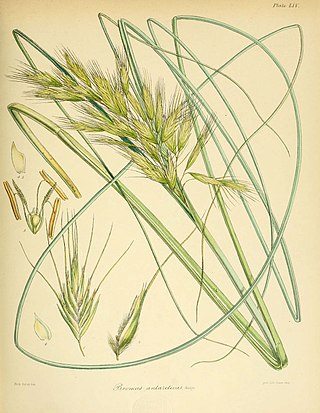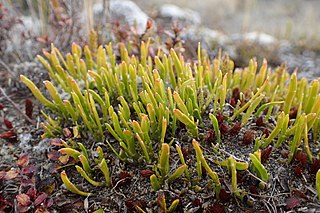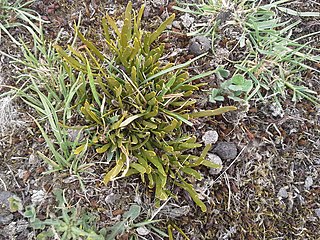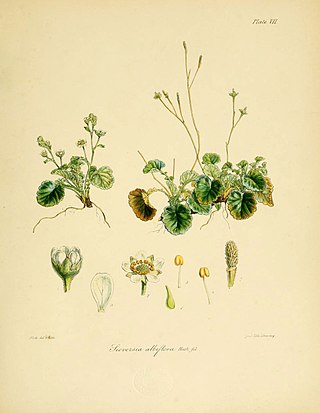
Alternanthera is a genus of flowering plants in the family Amaranthaceae. It is a widespread genus with most species occurring in the tropical Americas, and others in Asia, Africa, and Australia. Plants of the genus may be known generally as joyweeds, or Joseph's coat. Several species are notorious noxious weeds.

Olearia hectorii is a species of flowering plant in the daisy family Asteraceae. Its common names include deciduous tree daisy and Hector's tree daisy. It is endemic to New Zealand, where it is nationally endangered.

Dracophyllum longifolium, commonly called inaka, is an upright shrub or small tree in the family Ericaceae that is endemic to New Zealand.

Deschampsia chapmanii is a plant species in the grass (Poaceae) family, native to New Zealand and Macquarie Island.

Chionochloa antarctica is a species of grass, endemic to the Auckland and Campbell Islands.

Anthoxanthum brunonis is a species of grass, native to the South Island of New Zealand and to the Auckland and Campbell Islands.

Carmichaelia muritai, common name coastal tree broom, is a species of plant in the family Fabaceae. It is found only in the South Island of New Zealand.

Montigena is a genus of flowering plant in the legume family Fabaceae. It includes the sole species Montigena novae-zelandiae, known more commonly the scree pea, a dicotyledonous herb endemic to the South Island of New Zealand. The plant is small and woody, arising from thin, branched stems that extend to the surface from a deeply buried root stock. The flowers vary from purple to brown, while fruits appear between January and April.
Peter Brian Heenan is a New Zealand botanist.

Carmichaelia astonii is a species of pea in the family Fabaceae. It is found only in South Island of New Zealand. Its conservation status (2018) is "Nationally vulnerable" under the New Zealand Threat Classification System.

Carmichaelia appressa is a species of pea in the family Fabaceae. It is found only in the South Island of New Zealand. Its conservation status (2018) is "At Risk - Naturally Uncommon" under the New Zealand Threat Classification System.

Carmichaelia nana is a species of plant in the family Fabaceae. It is found in both the North and South Islands of New Zealand. Its conservation status in 2013 was assessed as "At Risk (declinining)" under the New Zealand Threat Classification System, but in 2018 its risk under the same system became "Threatened-Nationally Vulnerable".

Carmichaelia corrugata is a species of plant in the family Fabaceae. It is found only on the South Island of New Zealand.

Tupeia is a monotypic genus of semi-parasitic shrubs (mistletoes) which occurs in both the North and South Islands of New Zealand. There is only one species in the genus: Tupeia antarctica. There are no synonyms.

Azorella schizeilema is a species of cushion plant in the Apiaceae family, native to the Auckland and Campbell Islands.

Juncus antarcticus, also known as dwarf rush, is a flowering plant species in the rush family Juncaceae, native to New Zealand and Australia.

Leptinella lanata is a small flowering plant in the daisy family, native to the Antipodean Islands. Its specific epithet, lanata, describes its woolly-haired (lanate) rhizomes.

Geum albiflorum is a plant in the rose family, Rosaceae family, found in the Auckland Islands.

Actinotus novae-zelandiae is a plant in the Apiaceae family, native to the South Island of New Zealand.

Alternanthera denticulata is a small prostrate white-flowering herb in the Amaranthaceae family. It is native to all states and territories of Australia, New Guinea, and the North Island of New Zealand. It is also one of the food plants of the varied eggfly, Hypolimnas bolina nerina.



















